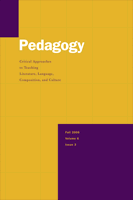With... Adam Sargant
-
It's our last episode of series 1!!! Expect ghost, ghouls and lots of
laughs as we round off the series with Adam Sargant, AKA Haunted Haworth.
We'll be...
7 hours ago
 Almost one year ago, we presented an issue of Pedagogy that devoted some articles to how to teach the Brontës nowadays. In the present number of Pedagogy, the topic is revisited with a new article that uses the recent paperback edition of the Oxford Companion to the Brontës.
Almost one year ago, we presented an issue of Pedagogy that devoted some articles to how to teach the Brontës nowadays. In the present number of Pedagogy, the topic is revisited with a new article that uses the recent paperback edition of the Oxford Companion to the Brontës.Instructors of courses on the Brontë family now have another large encyclopedic resource to use in their teaching of the lives and works of the family. Like Heather Glen's recently published Cambridge Companion to the Brontës (2002), this companion surveys the lives and writings of all of the family, including the father, Patrick, and brother, Branwell, while also covering some of the minute details in the works of the three sisters, Charlotte, Emily, and Anne. The question that I will address here is not which companion to use but how to use this particular resource. Of what use to instructors and students are detailed entries on specialized topics found in the lives and works?
The editors state in their preface that their purpose is to "evoke the milieu in which the Brontës lived and wrote, to disseminate new reliable research, and to provide detailed information about their lives, works, and reputation" (ix). With the assistance of seven other scholars and specialists on the Brontës, the editors have ably accomplished their stated intentions. This volume is as comprehensive as any instructor could wish, while at the same time also being specific and focused. For instance, the chronology at the front of the volume runs for almost twenty pages and places the lives of the Brontës into the context of larger literary and artistic movements as well as historical events (xxix–xlvii). In addition, the Oxford Companion includes numerous illustrations, including the drawings that Charlotte made to illustrate her early Angrian saga. Several useful maps are also provided, one that charts Charlotte's honeymoon tour of Ireland....


0 comments:
Post a Comment